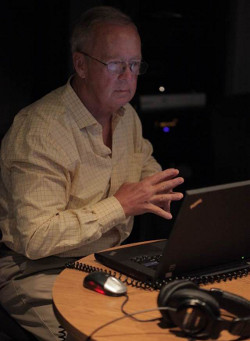Great article!
Finding Deep Note: The Story Behind THX’s Famous Sonic Swell Page 2

In the software, I had set up 30 oscillators, or “voices.” I had a main loop that went around and poked each voice once per second in sequence. At the top level was the timing of the overall piece&msash;the initial fade-in, the “chaos” in the first seconds, and, finally, the big chord; the ultimate pitches were assigned and the oscillators went shooting off to their assigned notes in the finale. This was all done in software running on the large special-purpose audio processing engine that we had built at Lucasfilm. It was capable of synthesis, but it was much more general than that. It could do real-time processing as well, and all the functions of a modern audio studio.
S&V: What’s the frequency makeup of the original Deep Note? How low does it go and what else is going on in that crescendo?
AM: The initial cluster starts with all 30 voices wandering around between G3 (G below middle-C) and G4 in a random fashion. After a point, they are assigned their final pitches. During the glissando, the frequency of each voice is moved directly toward the final pitch (as opposed to the random wanderings at the beginning of the piece). As the big chord comes into focus, the pitches are tightened up, but there is still some amount of randomness to make sure they didn’t all collapse onto the same pitch. I needed to detune them slightly, the way a piano tuner slightly detunes the multiple strings under each hammer.
S&V: You recently created a new version of Deep Note. How and why did you update it?
AM: I was contacted by the folks at THX last summer (2014). They wanted three different lengths (30, 45, and 60 seconds) and a number of different formats—stereo, 5.1, 7.1, and Dolby Atmos. I wrote the program to generate the Dolby Atmos version, which was the most complex, and simultaneously generated the other formats by mixing the voices in different ways. Since the piece is generated by a random number at the time the program is run, I wanted to make sure all versions were the same piece—that is, that they were all generated from the same random number. The simplest way to do that was to generate them all simultaneously.
 S&V: The updated version is described as faithful to the original but “intensely more complex.” How so?
S&V: The updated version is described as faithful to the original but “intensely more complex.” How so?
AM: I got to use many more voices than the original. I was constrained by the limited horsepower of the ASP to 30 voices. The new trailer uses almost 70 voices. Also I had more speakers to work with. The original was limited to four channels—left, center, right, and surround. The concept of 5.1 didn’t exist then, and there was no provision for left surround as different from right surround&msash;there was just one channel to the surrounds. That gave me quite a bit more freedom to assign sounds to the speakers, and to “fly” the voices around the theater. If you hear it in, say, 7.1, you will notice a great deal more spatial development than was possible in the original four-channel version.
S&V: Do you have anything else to add?
AM: Just to thank you for your interest in this piece of history, and thanks for giving me a chance to tell the story. I was the anonymous creator of the piece for decades. It is nice to be able to bring the story to the public after all these years. And, of course, my utmost gratitude goes to the folks at THX who gave me a chance to bring the piece up to date. It is something I had wanted to do for years but somehow never got around to doing. The new THX logo theme is about as far as I can take this musical idea. I know YouTube will resonate with exciting and creative reworkings of the concept for some time to come. I look forward to hearing another generation of musical ideas flow forth.
Editor’s Note: Per THX, “The new Deep Note, in all of its various mixes, is the soundtrack to the trailer Eclipse. With the new developments in object-based audio formats, we wanted to update the iconic 30-plus-year-old sound. Eclipse was released on April 2 and the 30-second stereo version is available online. Select THX Cinema partners received 5.1, 7.1, and Atmos mixes of the trailer in both 30- and 45-second versions. These are currently available only to those partners but, as with past trailers, we’ll expand access to THX fans in the near future.”
- Log in or register to post comments






























































